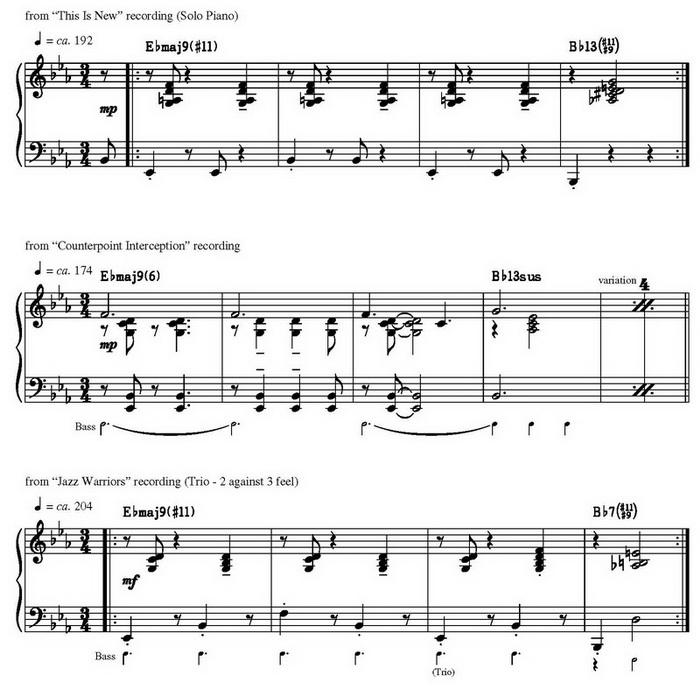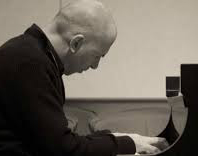Waltz For J.D. – Jon Davis
A 3/4 song with a definite lilt, due to the ornament-like triplet figures at the beginning of the melody. The Jon Davis Trio version is part of our Rhythm Section Workshop with Minus You tracks for piano, bass, and drums. A melody transcription is also available for this recording.
- Recording: Jon Davis - Jon Davis Trio
- Recorded on: September 4, 2010
- Label: jazzleadsheets.com (JLS 1043)
- Concert Key: E-flat
- Vocal Range: , to
- Style: 3/4 swing (medium up)
- Piano - Jon Davis
- Bass - Daryl Johns
- Drums - Steve Johns
Video
- Description
- Historical Notes
- Solos
- Piano Corner
- Bass Corner
- Drum Corner
- Guitar Corner
- Inside & Beyond
- Minus You
The first A and B sections are each 16 measures long; the second A section, while mostly identical to the first, begins with the last note of the phrase that concludes the first B section. The second B section begins like the first, but tags the 9th through 16th measures (with slightly different changes) to create a 24-measure section. The entire form is thus 72-measure ABAB'. The changes do not contain a lot of V-I motion but stay around the tonic key, flowing through some chromatic root motion and landing in E major eight measures from the end of both B sections. Solos are on the head form, while the coda tags the last 16 measures as a vamp; the melody returns the last time through this section to finish.
Each recording of this song (click on the Historical Notes tab for more details) has a different intro. On our recording, Jon begins with 32 measures based on an interlocking two-handed counterpoint pattern, with the bass and drums entering after 16 measures. This pattern is notated in our melody transcription. Click on the Minus You tab for more details about how this intro is written in the Minus You parts. Our lead sheet has no intro; anyone playing this song has the option of playing an intro similar to this recording or a different intro such as the simpler rhythmic ones on the other recordings. The lead sheet has a D.S. to the beginning of the head rather than a D.C., to imply space for an intro.
Our Melody Transcription shows the way Jon interprets his melody on the in and out heads. Notable left-hand accompanying rhythms are also included, as well as the last repeat of the coda vamp with the melody from the last 16 measures.

Jon Davis:
"Waltz For J.D. was written with two tunes in mind. I wanted to write a waltz that combined Windows by Chick Corea and Jitterbug Waltz by Fats Waller—sort of happy and moody at the same time—so that was the reference. I always liked waltzes a lot and liked playing both of those so I thought I would just write one that had a little of both."
On the drum solo, you can choose either to lay out—as bassist Daryl Johns did on the original trio recording—or to play under the drums with the piano. The 16-measure vamp section, which is played seven times, is a great place to have fun helping Jon build up the energy. Any bassist looking to interact on a higher level with soloists and navigate modern harmony will appreciate this play-along minus bass track!
Jon's interlocking two-handed counterpoint intro alternates one measure of 6/8 feel (two groups of three 8th notes) and one measure of 3/4 feel (three groups of two 8th notes). In the solo piano part of the intro, the 6/8 feel is more prominent. Therefore, the rhythm notated below the staff in the bass and drum parts is written in 6/8 at the beginning; where the bass and drums enter, the same rhythm is written in 3/4. The piano part is notated in 3/4 throughout, but with the implied 6/8 interpretation written under the staff at the beginning. The bass part and especially the drum part show notable melodic embellishments that Jon plays on the recording, based on the melody transcription. The piano and drum parts show the bass rhythms for the in and out heads (as well as the last eight measures of the first piano solo chorus) below the staff, while the bass part has the drum rhythms for the in head (and some of the out head) below the staff.
CLIP The form of this track is:
-- intro
16 measures solo piano
16 measures trio
-- melody
-- piano solo 2 choruses
-- bass solo 1 chorus
-- drum solo 1 chorus (piano comping)
-- out melody
-- coda: vamp repeats 7 times, then to [8] (one last time with melody)
mp3 minus Piano - the first half of the intro (solo piano) is kept in this track
-- no count off; tacet for the first 16 measures of the intro
-- play the last 16 measures of the intro (same pattern as written at the top)
-- play the melody
-- solo 2 choruses
-- comp for the bass solo 1 chorus
-- drum solo 1 chorus; optional comp or tacet
-- play the out melody
-- solo over the coda vamp 7 times
-- play [8]
mp3 minus Bass
-- no count off: tacet for the first 16 measures of the intro
-- play 1-feel for the last 16 measures of the intro
-- play 1-feel for the melody
-- play 1-feel for the piano solo 2 choruses
-- solo 1 chorus
-- drum solo 1 chorus; optional 1-feel or tacet
-- 1-feel for the out melody
-- 1-feel for the coda vamp 7 times
-- 1-feel for [8]
mp3 minus Drums - sticks throughout on the recording but brushes could also be used
-- no count off: tacet for the first 16 measures of the intro (piano only)
-- comp for the last 16 measures of the intro
-- comp for the melody
-- comp for the piano solo 2 choruses
-- comp for the bass solo 1 chorus
-- solo 1 chorus (piano is comping: clip with drums, clip without drums)
-- comp for the out melody
-- comp for the coda vamp 7 times
-- comp for [8]
Related Songs
Email Send Waltz For J.D. to a friend

Jon Davis
born on July 22, 1957
Jon Davis is a pianist and composer based in New York. He has performed with and contributed compositions to many of the top jazz musicians worldwide throughout his career, which has spanned over 35 years, and has recorded several albums as a leader. Jon took up piano and guitar as a young teenager; he was inspired to play jazz after hearing records of Red Garland and Miles Davis. He briefly studied with Lennie Tristano then attended New England Conservatory, where his teachers included Ran Blake, Jaki Byard, and Madam Chaloff. After six months, he left to begin gigging around Boston. Read more...

